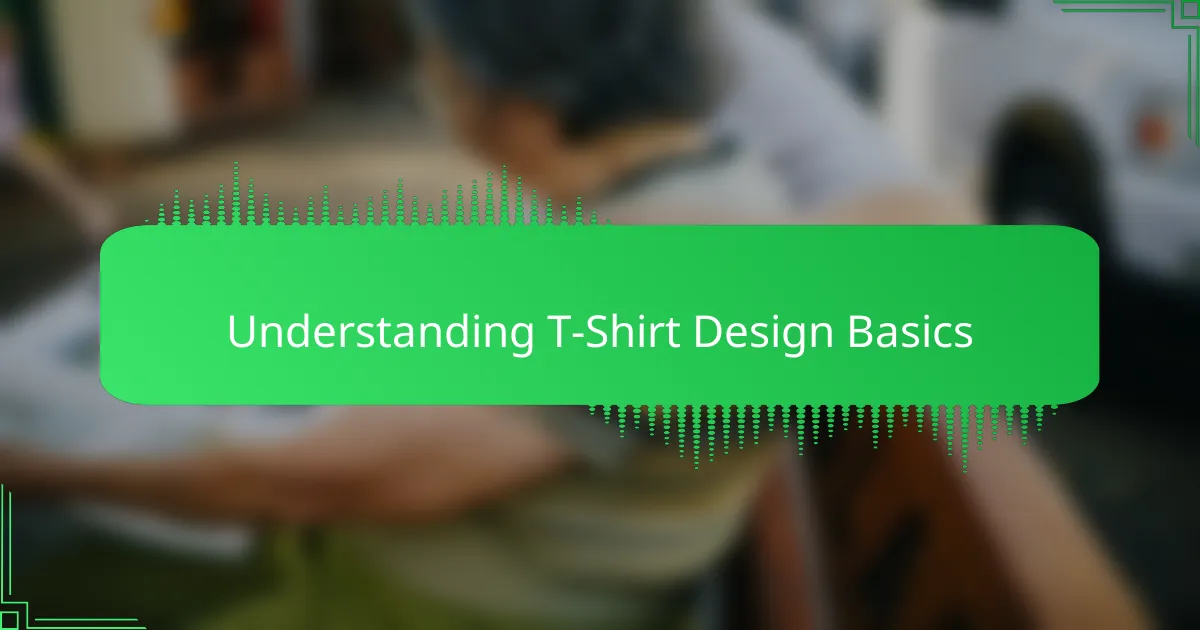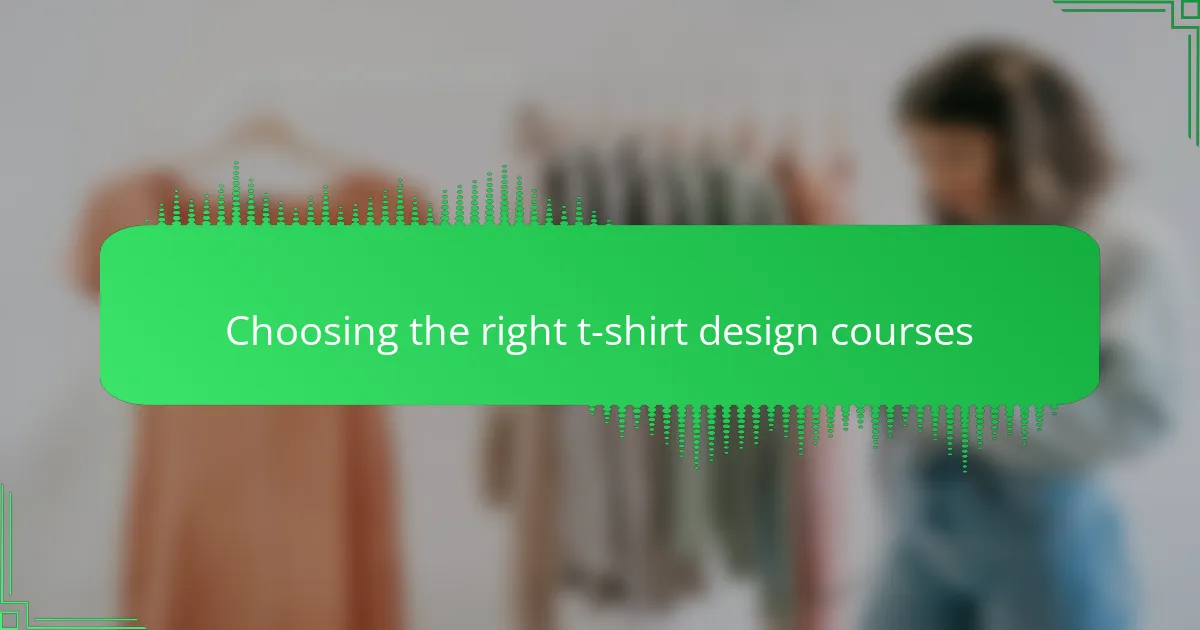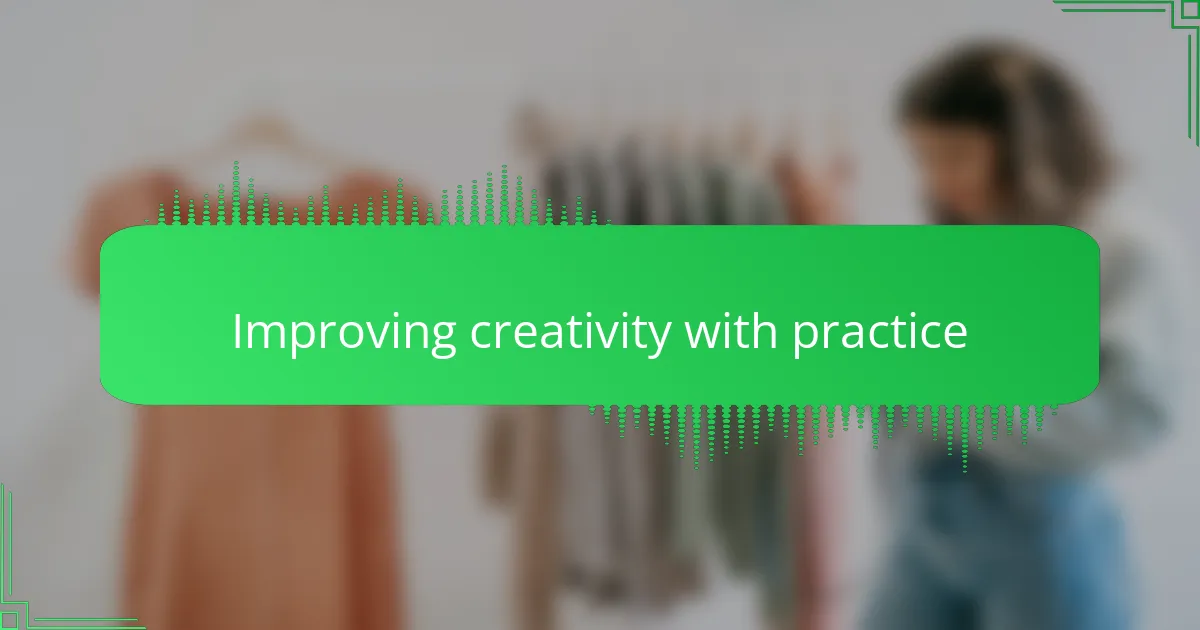Key takeaways
- Grasping design fundamentals like fabric types, color theory, and image resolution is essential for creating effective t-shirt designs.
- Skillshare offers a flexible learning platform with a wide range of classes that allow for practical application of design techniques.
- Choosing the right courses based on specific skills and instructor quality significantly enhances the learning experience.
- Regular practice and showcasing designs in context helps improve creativity and engage the audience more effectively.

Understanding t-shirt design basics
Grasping the fundamentals of t-shirt design is essential before diving into more complex techniques. When I first started, understanding concepts like fabric types, color theory, and image resolution saved me from a lot of trial and error. These basics lay the groundwork for creating designs that not only look good digitally but also print well on actual shirts.
Here are some key basics I focus on when learning t-shirt design:
- Fabric types and how they affect print quality
- Color theory to choose complementary and vibrant palettes
- Image resolution and file formats for clear, sharp prints
- Design placement and sizing to fit various shirt styles
- Understanding screen printing versus digital printing methods
Knowing these helped me create designs that feel professional and wearable, making the whole process more rewarding. Have you ever been excited about a design only to see it turn out dull on fabric? Getting these basics right can prevent that disappointment.

Exploring Skillshare for learning
When I first explored Skillshare for learning t-shirt design, I was amazed by the variety of classes available. It felt like discovering a treasure trove of creative possibilities, from mastering Adobe Illustrator to understanding color theory. Diving into these courses helped me overcome my initial hesitation and sparked new motivation to keep improving.
What stood out to me the most was how flexible and accessible the platform is. I could learn at my own pace, pausing and revisiting lessons whenever needed, which made the process less overwhelming. This approach transformed skill-building from a chore into an enjoyable habit.
- Wide range of classes on t-shirt design, including illustration, typography, and printing techniques
- Flexible learning schedule allowing you to tailor the pace to your own needs
- Access to industry-expert instructors sharing real-world tips and tricks
- Hands-on projects that help solidify concepts through practical application
- Community feedback features that boost motivation and provide constructive critiques

Choosing the right t-shirt design courses
Choosing the right t-shirt design courses on Skillshare can feel overwhelming at first because there are so many options. I remember scrolling through countless classes, wondering which one would truly fit my style and skill level. It helped me to focus on courses taught by instructors who not only had professional experience but also offered practical projects—those made the lessons stick much better for me.
I often ask myself: Does this course cover the specific techniques I want to improve? For example, if I’m aiming to master typography or digital illustration, selecting a course that dives deep into those areas makes all the difference. Choosing classes with clear, step-by-step guidance and downloadable resources gave me the confidence to experiment and create designs I’m proud of.
Sometimes, I ignored the rating and took a chance on a course because the preview spoke to me—trusting my gut worked out more often than not. Also, reading student reviews helped me avoid courses that were too basic or too advanced for my stage. Picking the right class felt like setting a solid foundation for my t-shirt design journey, and that choice was crucial for my growth.

Applying Skillshare lessons to projects
When I started applying Skillshare lessons directly to my t-shirt design projects, I noticed my confidence skyrocketed. It’s one thing to watch a tutorial, but actually using those techniques on real designs forced me to think critically and adapt what I learned to suit my style. That hands-on experience made the lessons stick far better than just passively watching.
One time, after a class on typography, I immediately revamped a design that was feeling dull. Seeing my work transform in front of my eyes was incredibly satisfying and motivated me to keep experimenting. Here’s how I usually apply what I learn from Skillshare to my projects:
- Recreate lesson exercises but customize them with my own concepts
- Incorporate new techniques into ongoing t-shirt design projects
- Use class feedback and project prompts as a guide for improvement
- Experiment with different styles or tools introduced in classes
- Share my Skillshare-based designs on social media to gather real-world feedback

Improving creativity with practice
Creativity doesn’t just appear out of nowhere; in my experience, it blossoms through consistent practice. I’ve found that the more I sketch, experiment, and push my design boundaries each day, the easier it is to generate fresh, original ideas. Have you ever noticed how a simple warm-up exercise can suddenly unlock a new creative spark? That’s the magic of practice at work.
At first, practicing felt like a repetitive chore, but over time it became a playground for exploration. I remember dedicating just 10 minutes daily to doodling t-shirt concepts, without worrying about perfection. Those small moments added up, boosting my confidence and creativity more than I expected.
What really clicked for me was embracing mistakes as part of practice. Instead of getting frustrated, I started asking, “What can this ‘flaw’ teach me?” That mindset shift made creative growth feel natural and even enjoyable. Improving creativity isn’t about instant genius—it’s about showing up regularly and letting your ideas evolve with each attempt.

Showcasing designs effectively
Showing off your t-shirt designs in the right way can make all the difference between a curious glance and a genuine connection. I realized early on that simply posting flat images wasn’t enough—mockups that place my designs on actual shirts helped others see the potential and visualized how the design would really look in real life. Have you ever noticed how a design pops differently when it’s seen worn on a body rather than just on a screen?
One thing I learned from Skillshare classes was the power of context. Presenting my designs in lifestyle photos or relatable settings added emotion and story to my work. It’s like giving your creations a little stage to shine on, making them memorable and engaging. When I started experimenting with background colors, lighting, and angles, my audience seemed to connect more deeply with my designs, and that motivated me to keep refining my presentation skills.
It also became clear to me that feedback is a vital part of showcasing. Sharing my designs in dedicated forums and Skillshare communities opened up fresh perspectives I hadn’t considered before. Instead of seeing critique as a hit to my confidence, I started viewing it as a helpful guide—kind of like having a team of friendly coaches cheering me on and pointing out ways to improve how I display my work. Have you tried asking for feedback on different mockups to figure out what really captivates your audience? That simple step changed how I approached showcasing my designs forever.
